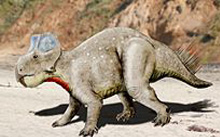Zhuchengceratops (phonetically spelled as Zhu-cheng-seh-rah-tops) is an Inexpectus type species dinosaur named by Xing Xu, Kebai Wang, Xijin Zhao, Corwin Sullivan & Shuqing Chen in 2010. The classification of the species is as follows:
Chordata – Reptilia – Dinosauria – Ornithischia – Ceratopsia – Leptoceratopsidae

The size of this species is estimated to be about 2 meters long and they followed an herbivorous diet. The known location of this species is the Wangshi Group in the Zhucheng County, Shandong Province, China. The fossil representation includes articulated partial skeleton, incomplete mandibles and maxillae.
The recovered specimen of Zhuchengceratops likely represents an adult, and is slightly larger than most adults of the similar ceratopsian Leptoceratops, which was around 2 meters in length. Zhuchengceratops is a genus of herbivorous ceratopsian dinosaur. It is a derived leptoceratopsid ceratopsian which lived during the Late Cretaceous period in what is now Kugou, Zhucheng County, China. This genus was named by Xing Xu, Kebai Wang, Xijin Zhao, Corwin Sullivan and Shuqing Chen in 2010, and the type species is Zhuchengceratops inexpectus.
The fossils contain a partial articulated skeleton including vertebrae, ribs, teeth, and parts of the skull and mandibles. They had a particularly massive and deep 50 cm-long mandible that is also thin transversely. This and a number of other autapomorphies unique to the genus, lend it significance for increasing the morphological disparity and the taxonomic diversity of the Leptoceratopsidae. As the third leptoceratopsid from Asia, this find exhibits the coexistence and radiation of two closely related clades. Their differences in jaw and tooth adaptation may represent different feeding strategies. The fossils of this species were largely recovered from the Wangshi Group.
| Name: | Zhuchengceratops (Zhucheng horned face). |
| Phonetic: | Zhu-cheng-seh-rah-tops. |
| Fossil representation: | Articulated partial skeleton, and incomplete mandibles (lower jaws) and maxillae. |